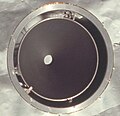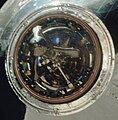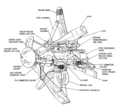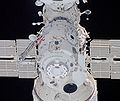Coupling (space travel)
In space travel, coupling is the connection between two spaceships or modules during a space rendezvous , which must be on an almost identical orbit . A later release of the connection is called decoupling .
The independent coupling of a free-flying spacecraft is also called docking ( English docking ), respectively. In contrast, the coupling with the aid of a robot arm as will applying ( English berthing ), respectively.
General
The purpose of the coupling can be purely technical (shared power supply , data exchange, etc.) or (in manned spaceflight ) to enable the crew to transfer to another module or a space station . The modules used up to now, for example the modules of the Mir space station, were used for celestial and earth observation and for biological, technical or physical experiments.
For a team to cross over, the connecting duct must be completely airtight and have a clear width of at least 70 cm, dressed in a space suit around 100 cm. After the rocket launch to change crew on the International Space Station , the docking takes place within two days, under the new regime already after 6 hours.
In order for two spacecraft to be able to couple with each other, their orbits must be almost identical and their mutual speed must fall below a technically prescribed limit, which for sensitive modules is in the range of a few centimeters per second (and this at orbit speeds between 7 and 8 km / s). The approximation of the two orbits usually takes place step by step, since the individual orbit maneuvers required for this are not possible with ultimate accuracy; in between, precise orbit determinations are required, which are mostly supported by terrestrial ground stations .
Only in the final approach phase - as soon as there is visual contact and the distances are less than a few kilometers - direct control by the astronauts is possible and useful. Aids for this are radar , Doppler effect and visual cross bearing . The fully automatic coupling was developed by Russia from around 1970 and has been common practice since around 2000. Typical docking relative speeds for this are or were:
- Space Shuttle : 2 cm / s
- Soyuz / Progress : 25 cm / s
- ATV : 7 cm / s
The first coupling of space travel took place on March 16, 1966 by Gemini 8 , controlled by Neil Armstrong and David Scott . The coupling partner was the Gemini Agena Target Vehicle , an unmanned target satellite.
The first automatic docking was carried out by two unmanned Soyuz spacecraft : Kosmos 186 and 188 docked on October 30, 1967.
In June 1997, a failed coupling maneuver between a Progress spaceship and the Mir space station led to a collision with the Spektr module of the space station, which was severely damaged in the process. The life of the Mir crew at the time was seriously endangered.
The Russian engineer Vladimir Siromyatnikov is considered to be the father of the Russian docking modules.
Soviet or Russian coupling systems
Coupling system contact
A coupling system called contact was developed for the lunar program . It consisted of a passive and an active part. The active part of the lunar spaceship Soyuz 7K-LOK should hook into a plate with several holes on the lunar landing module LK . However, this system was never used due to the problems with the N1 moon rocket .
Coupling system of the 7K-OK
This system also consists of a passive and an active part. The passive part has the shape of a funnel and accommodates the active part. This system was developed for coupling Soyuz spaceships to one another. It mechanically and electrically coupled the spaceships involved. However, there was no possibility for the spaceships to change spaceships through the coupling adapter. A switch could only be carried out by means of a space exit. The system was used for the first time during the flight of the unmanned Soyuz spacecraft Kosmos 186 and 188 .
SSWP
The coupling system was developed for coupling the Soyuz spaceships with the Salyut stations and consists of an active and a passive part.
APAS
The Androgynous Peripheral Attach System (APAS) ( Russian АСПП, Агрегат Стыковочный Пассивный Периферийный , device for passive peripheral coupling) was developed in 1975 as the APAS-75 system for the Apollo-Soyuz test project . In some cases, the terms Androgynous Peripheral Assembly System (APAS) and Androgynous Peripheral Docking System (APDS) were also used for the coupling technology.
Later, on the Soviet side, this resulted in the APAS-89 system for coupling the Buran space shuttle to the Mir space station . US space shuttles were also able to dock with the Mir using an adapter . For the ISS , the system was further developed as APAS-95 to couple the space shuttles.
System sketch APAS-75 of Soyuz 7K-TM
The androgynous coupling system APAS-89 from Buran , further developed for the space shuttle to APAS-95
American coupling systems
Apollo docking system
Conceptually similar to the Soyuz system, the docking system of the Apollo spacecraft consisted of an active part on the command module (CM) and a passive part on the lunar module (or on the MDA in the case of Skylab ). The probe of the active part, controlled by one of the two spaceships, was inserted into the cone of the passive part and pulled up by a spring system. Twelve claw-like bolts snapped into place on the outer diameter and firmly connected the vehicles together. The probe and cone then had to be removed and stored manually. The connection could be separated electrically, on the one hand, by unlocking the latch, and, on the other hand, pyrotechnically by blowing off the entire docking hardware (which then remained on the passive side).
the command and service module (left) shortly before contact with the ascent stage of the Apollo lunar module (right)
Coupling socket of the International Space Station (ISS)
Various coupling mechanisms are used to couple the modules of the ISS , depending on the purpose. There are various coupling systems for the pressurized parts, as well as for modules or equipment carriers that are not under pressure. The Russian part uses the systems already developed in the Soviet Union , while the US part uses different systems. The Pressurized Mating Adapter-1 with a passive Common Berthing Mechanism on the US and a passive APAS-95 connector on the Russian side is used to couple the two main parts of the ISS .
With the International Docking System Standard , the partners of the ISS created an open standard for coupling adapters in 2010, which is intended to reduce the variety of systems in international space travel or to create systems that are compatible with one another.
APAS-95
The Russian "Androgynous Peripheral Attach System" (APAS-95) is the further development of the APAS-89 system . It is used to connect the Russian part with the US part of the ISS on the Pressurized Mating Adapter PMA-1. In addition, feeder vehicles were used to dock on PMAs 2 and 3 before they were converted to the IDSS standard in 2016 and 2019 using IDA adapters .
APAS-95 in active operating mode on the space shuttle
APAS-95 in passive operating mode on PMA-2
SSWP G4000
This is the passive part of the Soyuz coupling system and is installed on Pirs , Poisk , Rasswet and Zvezda for coupling Soyuz, Progress and ATV .
Passive coupling adapter of the Sojust type to Pirs
Active coupling adapter on the Russian space freighter Progress
SSWP M8000
The SSWP M8000 is a so-called hybrid system that was developed from SSWP and APAS for coupling the large Russian modules. This uses the outer ring of the APAS and the "funnel-rod" design of the SSWP. It therefore has a larger diameter than the SSWP G4000. It is used to couple the modules Sarja , Zvezda , Pirs and Poisk .
CBM
The American " Common Berthing Mechanism " (CBM) is also suitable for large items of freight with a diameter of 127 cm. It connects the US parts of the ISS with each other and was used for docking with the Multi-Purpose Logistics Module . Now the Japanese HTV supply spaceship, the Dragon and the Cygnus use this mechanism.
MPLM , shuttle cargo module
HTV , Japanese supply module
PMA-1 , the Russian-American liaison office of the ISS
LIDS
The US-American Low Impact Docking System (LIDS) was intended for the coupling of the originally planned X-38 Crew Return Vehicle, which was discontinued in 2002 . It should represent the next generation of the APAS coupling adapter. Originally the Orion spaceship was supposed to be equipped with this adapter in order to be able to dock with the ISS. Since NASA no longer plans to fly the Orion spacecraft to the ISS, this project has been discontinued. The adapter development was continued in the international Low Impact Docking System (iLIDS) and the NASA Docking System (NDS) , which were designed to be compatible with the IDSS standard.
IBDM
The International Berthing and Docking Mechanism (IBDM) is being developed under the direction of ESA. At the beginning of 2016 it was announced that ESA will provide the first docking adapter for the Dream Chaser . The IBDM is compatible with the IDSS standard.
NDS
NDS , the NASA Docking System, is NASA's practical implementation of the IDSS standard. The NDS was first performed on the IDA adapters. These have an APAS-95 docking socket on the space station side and were placed on the two free PMAs. IDA1 was lost at launch in 2015. IDA2 was brought to the ISS and assembled in 2016 and IDA3 in 2019. In 2019, a spaceship, a Dragon V2 , docked there for the first time . The new spaceships CST-100 Starliner and Dream Chaser are also supposed to dock at the NDS nozzle.
SSAS
The Segment to Segment Attachment System (SSAS) connects parts of the Integrated Truss Structure : S0 with S1, S1 with S3, as well as S0 with P1 and P1 with P3.
RTAS
The Rocketdyne Truss Attachment System (RTAS) connected Z1 to P6 during the construction of the station. After completion, the RTAS connects P6 with P5 and S6 with S5.
MRTAS
The Modified Rocketdyne Truss Attachment System (MRTAS) consists of a passive and an active part and connects P5 with P4 and S5 with S4.
See also
- For the theory of level crossings see celestial mechanics and transition orbit .
literature
- Albert Ducrocq : Victory over Space , rororo 1961
- Richard Heinrich Giese : Space Technology Volume I, Bibliographic Institute, Mannheim 1966
- R. Wallisfurth, Russia's way to the moon . Econ-Verlag, Vienna-Düsseldorf 1964
- Wigbert Fehse : Handbook Automated Rendezvous and Docking of Spacecraft. Cambridge University Press, 2008 ( online information )
Web links
swell
- ↑ James Oberg: When two spacecraft meet, they rely on Vladimir Syromyatnikov. IEEE Spectrum, April 1, 2006, accessed June 29, 2013 .
- ↑ a b David SF Portree: MIR Hardware Heritage. (PDF; 4 MB) NASA, 1995, accessed on June 28, 2013 (English).
- ↑ Anatoly Zak: Docking system. RussianSpaceWeb, March 30, 2013, accessed June 29, 2013 (English).
- ^ Suzy McHale: ISS docking systems. Retrieved August 28, 2008 .
- ↑ a b ISS Interface Mechanisms and their Heritage. (PDF; 3 MB) NASA, accessed on November 4, 2011 (English).
- ↑ NDS Configuration and Requirements Changes since Nov 2010. (PDF; 1 MB) NASA, June 14, 2011, archived from the original on February 15, 2013 ; accessed on January 6, 2019 .
- ↑ Europe to invest in Sierra Nevada's Dream Chaser cargo vehicle. SpaceNews.com, January 22, 2016, accessed December 27, 2018 .
















